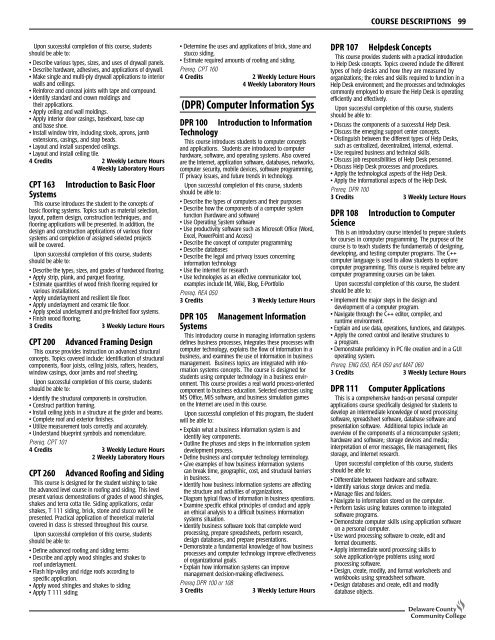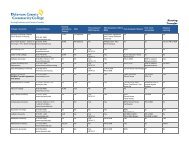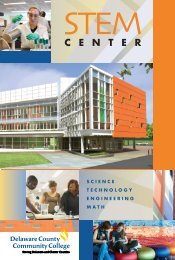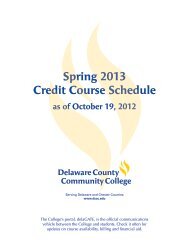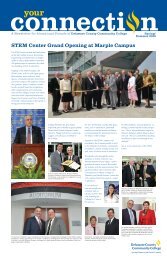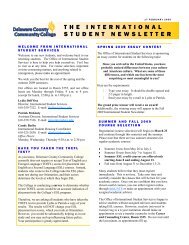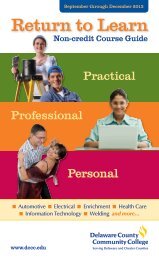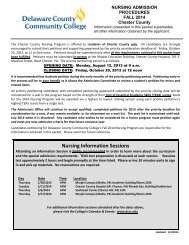2010 Catalog - Delaware County Community College
2010 Catalog - Delaware County Community College
2010 Catalog - Delaware County Community College
Create successful ePaper yourself
Turn your PDF publications into a flip-book with our unique Google optimized e-Paper software.
COURSE DESCRIPTIONS 99<br />
Upon successful completion of this course, students<br />
should be able to:<br />
• Describe various types, sizes, and uses of drywall panels.<br />
• Describe hardware, adhesives, and applications of drywall.<br />
• Make single and multi-ply drywall applications to interior<br />
walls and ceilings.<br />
• Reinforce and conceal joints with tape and compound.<br />
• Identify standard and crown moldings and<br />
their applications.<br />
• Apply ceiling and wall moldings.<br />
• Apply interior door casings, baseboard, base cap<br />
and base shoe.<br />
• Install window trim, including stools, aprons, jamb<br />
extensions, casings, and stop beads.<br />
• Layout and install suspended ceilings.<br />
• Layout and install ceiling tile.<br />
4 Credits 2 Weekly Lecture Hours<br />
4 Weekly Laboratory Hours<br />
CPT 163<br />
Introduction to Basic Floor<br />
Systems<br />
This course introduces the student to the concepts of<br />
basic flooring systems. Topics such as material selection,<br />
layout, pattern design, construction techniques, and<br />
flooring applications will be presented. In addition, the<br />
design and construction applications of various floor<br />
systems and completion of assigned selected projects<br />
will be covered.<br />
Upon successful completion of this course, students<br />
should be able to:<br />
• Describe the types, sizes, and grades of hardwood flooring.<br />
• Apply strip, plank, and parquet flooring.<br />
• Estimate quantities of wood finish flooring required for<br />
various installations.<br />
• Apply underlayment and resilient tile floor.<br />
• Apply underlayment and ceramic tile floor.<br />
• Apply special underlayment and pre-finished floor systems.<br />
• Finish wood flooring.<br />
3 Credits 3 Weekly Lecture Hours<br />
CPT 200<br />
Advanced Framing Design<br />
This course provides instruction on advanced structural<br />
concepts. Topics covered include: identification of structural<br />
components, floor joists, ceiling joists, rafters, headers,<br />
window casings, door jambs and roof sheeting.<br />
Upon successful completion of this course, students<br />
should be able to:<br />
• Identify the structural components in construction.<br />
• Construct partition framing.<br />
• Install ceiling joists in a structure at the girder and beams.<br />
• Complete roof and exterior finishes.<br />
• Utilize measurement tools correctly and accurately.<br />
• Understand blueprint symbols and nomenclature.<br />
Prereq. CPT 101<br />
4 Credits 3 Weekly Lecture Hours<br />
2 Weekly Laboratory Hours<br />
CPT 260<br />
Advanced Roofing and Siding<br />
This course is designed for the student wishing to take<br />
the advanced level course in roofing and siding. This level<br />
present various demonstrations of grades of wood shingles,<br />
shakes and terra cotta tile. Siding applications, cedar<br />
shakes, T 111 siding, brick, stone and stucco will be<br />
presented. Practical application of theoretical material<br />
covered in class is stressed throughout this course.<br />
Upon successful completion of this course, students<br />
should be able to:<br />
• Define advanced roofing and siding terms<br />
• Describe and apply wood shingles and shakes to<br />
roof underlayment.<br />
• Flash hip-valley and ridge roofs according to<br />
specific application.<br />
• Apply wood shingles and shakes to siding<br />
• Apply T 111 siding<br />
• Determine the uses and applications of brick, stone and<br />
stucco siding.<br />
• Estimate required amounts of roofing and siding.<br />
Prereq. CPT 160<br />
4 Credits 2 Weekly Lecture Hours<br />
4 Weekly Laboratory Hours<br />
(DPR) Computer Information Sys<br />
DPR 100<br />
Introduction to Information<br />
Technology<br />
This course introduces students to computer concepts<br />
and applications. Students are introduced to computer<br />
hardware, software, and operating systems. Also covered<br />
are the Internet, application software, databases, networks,<br />
computer security, mobile devices, software programming,<br />
IT privacy issues, and future trends in technology.<br />
Upon successful completion of this course, students<br />
should be able to:<br />
• Describe the types of computers and their purposes<br />
• Describe how the components of a computer system<br />
function (hardware and software)<br />
• Use Operating System software<br />
• Use productivity software such as Microsoft Office (Word,<br />
Excel, PowerPoint and Access)<br />
• Describe the concept of computer programming<br />
• Describe databases<br />
• Describe the legal and privacy issues concerning<br />
information technology<br />
• Use the internet for research<br />
• Use technologies as an effective communicator tool,<br />
examples include IM, Wiki, Blog, E-Portfolio<br />
Prereq. REA 050<br />
3 Credits 3 Weekly Lecture Hours<br />
DPR 105<br />
Management Information<br />
Systems<br />
This introductory course in managing information systems<br />
defines business processes, integrates these processes with<br />
computer technology, explains the flow of information in a<br />
business, and examines the use of information in business<br />
management. Business topics are integrated with information<br />
systems concepts. The course is designed for<br />
students using computer technology in a business environment.<br />
This course provides a real world process-oriented<br />
component to business education. Selected exercises using<br />
MS Office, MIS software, and business simulation games<br />
on the Internet are used in this course.<br />
Upon successful completion of this program, the student<br />
will be able to:<br />
• Explain what a business information system is and<br />
identify key components.<br />
• Outline the phases and steps in the information system<br />
development process.<br />
• Define business and computer technology terminology.<br />
• Give examples of how business information systems<br />
can break time, geographic, cost, and structural barriers<br />
in business.<br />
• Identify how business information systems are affecting<br />
the structure and activities of organizations.<br />
• Diagram typical flows of information in business operations.<br />
• Examine specific ethical principles of conduct and apply<br />
an ethical analysis to a difficult business information<br />
systems situation.<br />
• Identify business software tools that complete word<br />
processing, prepare spreadsheets, perform research,<br />
design databases, and prepare presentations.<br />
• Demonstrate a fundamental knowledge of how business<br />
processes and computer technology improve effectiveness<br />
of organizational goals.<br />
• Explain how information systems can improve<br />
management decision-making effectiveness.<br />
Prereq DPR 100 or 108<br />
3 Credits 3 Weekly Lecture Hours<br />
DPR 107<br />
Helpdesk Concepts<br />
This course provides students with a practical introduction<br />
to Help Desk concepts. Topics covered include the different<br />
types of help desks and how they are measured by<br />
organizations; the roles and skills required to function in a<br />
Help Desk environment; and the processes and technologies<br />
commonly employed to ensure the Help Desk is operating<br />
efficiently and effectively.<br />
Upon successful completion of this course, students<br />
should be able to:<br />
• Discuss the components of a successful Help Desk.<br />
• Discuss the emerging support center concepts.<br />
• Distinguish between the different types of Help Desks,<br />
such as centralized, decentralized, internal, external.<br />
• Use required business and technical skills.<br />
• Discuss job responsibilities of Help Desk personnel.<br />
• Discuss Help Desk processes and procedures.<br />
• Apply the technological aspects of the Help Desk.<br />
• Apply the informational aspects of the Help Desk.<br />
Prereq. DPR 100<br />
3 Credits 3 Weekly Lecture Hours<br />
DPR 108<br />
Introduction to Computer<br />
Science<br />
This is an introductory course intended to prepare students<br />
for courses in computer programming. The purpose of the<br />
course is to teach students the fundamentals of designing,<br />
developing, and testing computer programs. The C++<br />
computer language is used to allow students to explore<br />
computer programming. This course is required before any<br />
computer programming courses can be taken.<br />
Upon successful completion of this course, the student<br />
should be able to:<br />
• Implement the major steps in the design and<br />
development of a computer program.<br />
• Navigate through the C++ editor, compiler, and<br />
runtime environment.<br />
• Explain and use data, operations, functions, and datatypes.<br />
• Apply the correct control and iterative structures to<br />
a program.<br />
• Demonstrate proficiency in PC file creation and in a GUI<br />
operating system.<br />
Prereq. ENG 050, REA 050 and MAT 060<br />
3 Credits 3 Weekly Lecture Hours<br />
DPR 111<br />
Computer Applications<br />
This is a comprehensive hands-on personal computer<br />
applications course specifically designed for students to<br />
develop an intermediate knowledge of word processing<br />
software, spreadsheet software, database software and<br />
presentation software. Additional topics include an<br />
overview of the components of a microcomputer system;<br />
hardware and software; storage devices and media;<br />
interpretation of error messages, file management, files<br />
storage, and Internet research.<br />
Upon successful completion of this course, students<br />
should be able to:<br />
• Differentiate between hardware and software.<br />
• Identify various storge devices and media.<br />
• Manage files and folders.<br />
• Navigate to information stored on the computer.<br />
• Perform tasks using features common to integrated<br />
software programs.<br />
• Demonstrate computer skills using application software<br />
on a personal computer.<br />
• Use word processing software to create, edit and<br />
format documents.<br />
• Apply intermediate word processing skills to<br />
solve application-type problems using word<br />
processing software.<br />
• Design, create, modify, and format worksheets and<br />
workbooks using spreadsheet software.<br />
• Design databases and create, edit and modify<br />
database objects.


